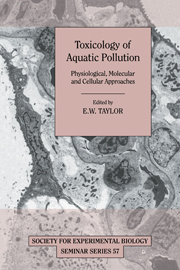Book contents
- Frontmatter
- Contents
- List of contributors
- Preface
- Water chemistry at the gill surfaces of fish and the uptake of xenobiotics
- Bioaccumulation of waterborne 1,2,4,5-tetrachlorobenzene in tissues of rainbow trout
- Dietary exposure to toxic metals in fish
- The physiology and toxicology of zinc in fish
- Lethal and sub-lethal effects of copper upon fish: a role for ammonia toxicity?
- The physiological status of brown trout exposed to aluminium in acidic soft waters
- Physiological and metabolic costs of acclimation to chronic sub-lethal acid and aluminium exposure in rainbow trout
- Physiological effects of nitrite in teleosts and crustaceans
- Metallothioneins in fish: induction and use in environmental monitoring
- Oestrogenic substances in the aquatic environment and their potential impact on animals, particularly fish
- Effect of genetic toxicants in aquatic organisms
- In vitro toxicology of aquatic pollutants: use of cultured fish cells
- Principles governing the use of cytochrome P4501A1 measurement as a pollution monitoring tool in the aquatic environment
- Index
Dietary exposure to toxic metals in fish
Published online by Cambridge University Press: 20 May 2010
- Frontmatter
- Contents
- List of contributors
- Preface
- Water chemistry at the gill surfaces of fish and the uptake of xenobiotics
- Bioaccumulation of waterborne 1,2,4,5-tetrachlorobenzene in tissues of rainbow trout
- Dietary exposure to toxic metals in fish
- The physiology and toxicology of zinc in fish
- Lethal and sub-lethal effects of copper upon fish: a role for ammonia toxicity?
- The physiological status of brown trout exposed to aluminium in acidic soft waters
- Physiological and metabolic costs of acclimation to chronic sub-lethal acid and aluminium exposure in rainbow trout
- Physiological effects of nitrite in teleosts and crustaceans
- Metallothioneins in fish: induction and use in environmental monitoring
- Oestrogenic substances in the aquatic environment and their potential impact on animals, particularly fish
- Effect of genetic toxicants in aquatic organisms
- In vitro toxicology of aquatic pollutants: use of cultured fish cells
- Principles governing the use of cytochrome P4501A1 measurement as a pollution monitoring tool in the aquatic environment
- Index
Summary
Introduction
The ingestion of contaminated food is considered a primary route of metal intoxication in terrestrial organisms. Consequently, the mammalian literature contains a wealth of information on the ingestion, absorption and oral toxicity of metals. In contrast, the effects of oral doses of metals in fish are mostly unknown, except in the context of nutrition (Ogino & Yang, 1978, 1980; Ketola, 1979; Knox, Cowey & Adron, 1982, 1984; Hardy & Shearer, 1985; Poston, 1991). The general belief that the gills are the main route of toxicant absorption in fish has also diverted attention from oral toxicity studies. Early laboratory investigations confirmed that fish can absorb metal poisons across the gut (Aoyama, Inoue & Inoue, 1978a,b; Patrick & Loutit, 1978), but the toxicological significance of these observations remains unclear despite field data on contamination levels in food species (Krantzberg & Stokes, 1989; Yevtushenko, Bren & Sytnik, 1990; Wren & Stephenson, 1991; Miller, Munkittrick & Dixon, 1992). However, at least one research team has confirmed the diet as an important route of contamination in wild fish (Dallinger & Kautzky, 1985; Dallinger et al, 1987). Aquatic microcosms have also been used successfully in trophic studies (Rodgers et al., 1987), while more recently radiotracer studies in whole ecosystems have yielded information on the trophic transfer of toxic metals (Cope, Wiener & Rada, 1990; Harrison, Klaverkamp & Hesslien, 1990). The available information on the occurrence, intestinal absorption, excretion, accumulation, and oral toxicity of Hg, Cd, Al, Cu and Zn are summarized here. References to the mammalian literature are made for comparison and where data on fish are lacking.
- Type
- Chapter
- Information
- Toxicology of Aquatic PollutionPhysiological, Molecular and Cellular Approaches, pp. 29 - 60Publisher: Cambridge University PressPrint publication year: 1996
- 43
- Cited by



